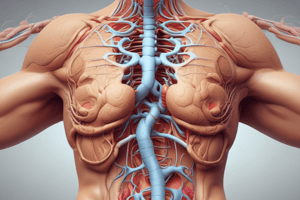Podcast
Questions and Answers
At what level does the common carotid artery terminate?
At what level does the common carotid artery terminate?
- T1 vertebra
- Lower border of the thyroid cartilage
- C7 vertebra
- Upper border of the thyroid cartilage (correct)
Which artery arises from the anterior aspect of the external carotid artery?
Which artery arises from the anterior aspect of the external carotid artery?
- Maxillary artery
- Occipital artery
- Superficial temporal artery
- Facial artery (correct)
Where does the left common carotid artery originate from?
Where does the left common carotid artery originate from?
- Superior vena cava
- Aortic arch (correct)
- Brachiocephalic trunk
- Innominate artery
Where does the right common carotid artery arise from?
Where does the right common carotid artery arise from?
What is the termination point of the external carotid artery?
What is the termination point of the external carotid artery?
What structures does the common carotid artery travel with within the carotid sheath?
What structures does the common carotid artery travel with within the carotid sheath?
The glossopharyngeal nerve originates in which part of the brain?
The glossopharyngeal nerve originates in which part of the brain?
Which vein drains into the subclavian vein?
Which vein drains into the subclavian vein?
Which artery supplies the inferior surface of the cerebellum?
Which artery supplies the inferior surface of the cerebellum?
Where does the anterior spinal artery descend along?
Where does the anterior spinal artery descend along?
Where does the glossopharyngeal nerve leave the cranium?
Where does the glossopharyngeal nerve leave the cranium?
Which arteries join to form the basilar artery?
Which arteries join to form the basilar artery?
What is the function of the tympanic nerve?
What is the function of the tympanic nerve?
Where does the posterior auricular vein and retromandibular vein combine?
Where does the posterior auricular vein and retromandibular vein combine?
At which level does the sternal angle (Angle of Louis) lie?
At which level does the sternal angle (Angle of Louis) lie?
Which rib only articulates with T10 and has one articular facet?
Which rib only articulates with T10 and has one articular facet?
Which muscle is considered as the most important muscle of the thoracic wall?
Which muscle is considered as the most important muscle of the thoracic wall?
Which part of the rib articulates with the vertebral bodies?
Which part of the rib articulates with the vertebral bodies?
At what level does the xiphisternal joint lie?
At what level does the xiphisternal joint lie?
What is the primary component of normal respiration?
What is the primary component of normal respiration?
Which muscle forms the lateral part of the innermost layer of the thoracic wall?
Which muscle forms the lateral part of the innermost layer of the thoracic wall?
Which nerve is joined to the brachial plexus?
Which nerve is joined to the brachial plexus?
Which nerve receives a gray ramus from the corresponding ganglion of the sympathetic trunk?
Which nerve receives a gray ramus from the corresponding ganglion of the sympathetic trunk?
What type of branch does the intercostal nerve give to a ganglion of the sympathetic trunk?
What type of branch does the intercostal nerve give to a ganglion of the sympathetic trunk?
Flashcards are hidden until you start studying
Study Notes
Common Carotid Artery
- Terminates at the level of the fourth cervical vertebra (C4).
- Travels with the internal jugular vein and vagus nerve within the carotid sheath.
External Carotid Artery
- The superior thyroid artery arises from the anterior aspect of the external carotid artery.
- Terminates by bifurcating into the maxillary and superficial temporal arteries.
Common Carotid Artery Origins
- Left common carotid artery originates from the arch of the aorta.
- Right common carotid artery arises from the brachiocephalic trunk.
Glossopharyngeal Nerve
- Originates in the medulla oblongata of the brain.
- Leaves the cranium through the jugular foramen.
Arteries and Veins
- The basilar artery is formed by the union of the two vertebral arteries.
- The artery that supplies the inferior surface of the cerebellum is the posterior inferior cerebellar artery.
- Subclavian vein is drained by the external jugular vein.
Veins
- The posterior auricular vein and the retromandibular vein combine to form the external jugular vein.
Thoracic Anatomy
- The sternal angle (Angle of Louis) lies at the level of the second rib.
- Rib 10 articulates only with the T10 vertebra and has one articular facet.
- The primary muscle of the thoracic wall is the pectoralis major.
- The part of the rib that articulates with the vertebral bodies is the head of the rib.
- The xiphisternal joint lies at the level of the ninth thoracic vertebra (T9).
- The primary component of normal respiration is the diaphragm.
Intercostal Nerve
- The lateral part of the innermost layer of the thoracic wall is formed by the internal intercostal muscle.
- Intercostal nerve receives a gray ramus from the corresponding ganglion of the sympathetic trunk.
- Intercostal nerve gives a white ramus communicantes to the sympathetic trunk's ganglion.
Brachial Plexus
- The nerve that is joined to the brachial plexus is the long thoracic nerve.
Studying That Suits You
Use AI to generate personalized quizzes and flashcards to suit your learning preferences.




